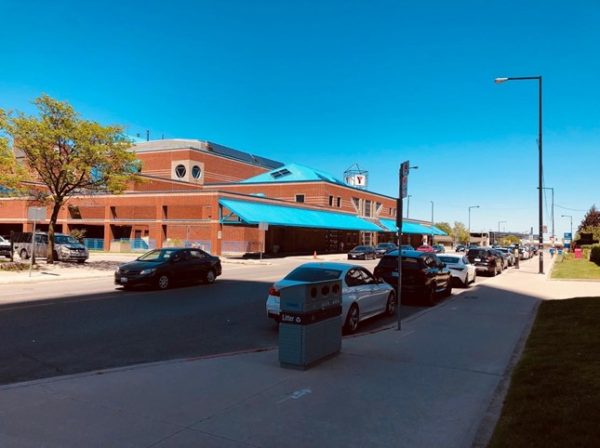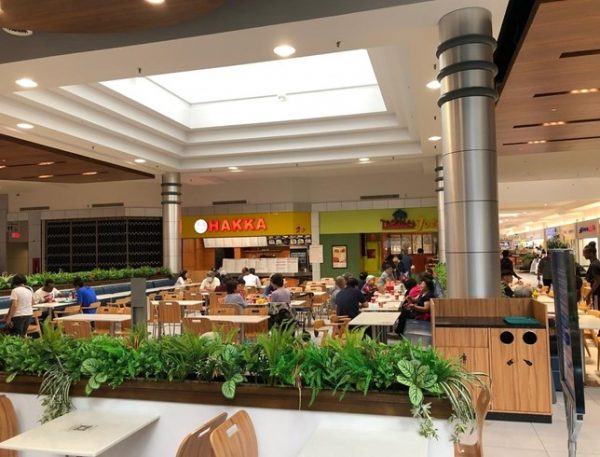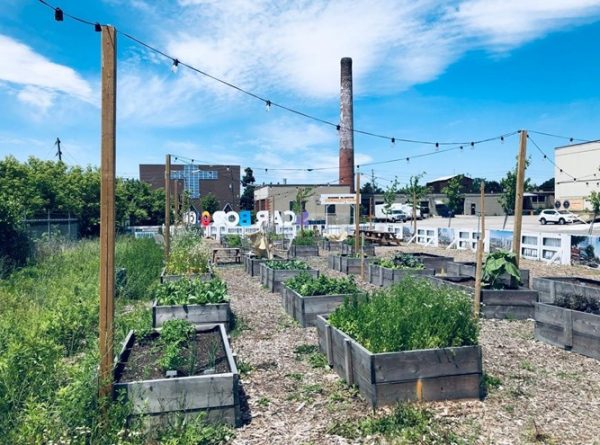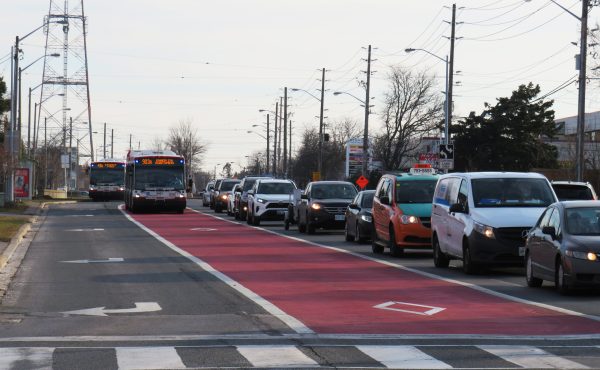With Mahira Khan, Alexander Nazarov, Anastasiia Ostrovskaia, and Mikayla Sinclair
In this “Transit Transformation” series, University of Toronto Scarborough (UTSC) City Studies students lead an investigation into the Scarborough subway extension. Zachary Hyde is a professor in the City Studies Program at the University of Toronto Scarborough. Mahira Khan, Alexander Nazarov, Anastasiia Ostrovskaia, and Mikayla Sinclair are students in the City Studies Program at the University of Toronto Scarborough.
On a spring day earlier this year Alexander Nazarov, a city studies major at the University of Toronto Scarborough, engages a group of students making their way out of language class. The students are leaving the Town Centre Language Instruction for Newcomers to Canada (LINC) program, which is nearby the new subway station under construction at Sheppard Avenue and McCowan Road. Alexander, who came to Canada with his family at age 5, attended daycare at LINC while his parents took language classes. He is interested in learning more about the importance of the centre to local community life in Scarborough.
He strikes up a conversation with two young women, Mary and Christine, who became friends after meeting at the multicultural conversation circle held at Town Centre LINC on Tuesdays. He learns that Mary has just been giving Christine advice on a course she can take to learn to how to file her taxes in Canada. He approaches another set of young people, who he learns live in a nearby affordable multi-family rental housing tower. They tell him the location allows them to attend classes while their kids attend the free onsite daycare offered by LINC, and then make use of the internet at the nearby Civic Centre Library
The experiences Alexander documents at Town Centre LINC point to the importance of community spaces to the social fabric of Scarborough. Through programs like LINC, newcomers build lasting social bonds – something which was key for Alexander and his family when they first moved to Canada. Alexander is now planning to do a Master’s degree at the Ontario Institute for Studies in Education to pursue a career as a French teacher.
In the second part of this series, we explore the impact of the new Scarborough Subway Extension (SSE) on Scarborough’s community spaces. Large-scale redevelopments and rising land prices can threaten affordability for small community organizations and services, like LINC. Changing demographics can also alter who uses these spaces and for what purpose. To explore these questions, a team of student researchers from the City Studies Program at UTSC did on-the-ground observations, interviews, and analyses of real estate marketing material to identify key areas for local policy makers in planning for the SSE.
Community spaces and the potential for displacement
The Scarborough Town Centre YMCA is instantly recognizable from its vibrant teal roof. The centre opened in 1991 and has been a key amenity ever since. It provides swimming classes for children, a well-used gym, and an employment service office for young people. Given its affordable programming, it is heavily used by newcomers to Canada.

Mikayla Sinclair carried out research on community life in Scarborough by doing observations at the YMCA over several weeks in March of this year. Mikayla, who grew up in Ajax, is now majoring in Sociology at UTSC and is planning to pursue a career in law. Through observations of the lobby and gym area, she saw employees helping newcomer parents with limited English enroll their children into programming, advise teenagers looking for part time work, and direct people looking for addictions treatment to other services in the area. The YMCA is often the first place people turn to if they need help with a personal or community problem.
Mikayla and Alexander’s research on the YCMA and LINC near the Scarborough Subway Extension provide a useful comparison of different types of displacement that can happen to community spaces. Alexander identifies LINC as being at risk of physical displacement. The program is housed in a strip mall by the 401, which could be the site of incoming developments. If the site were to go up for sale, he proposes the city require the developer to build a new location for LINC as a part of the city’s Section 37 Community Benefits Charge.
Mikayla’s research points to different potential side effect of the SSE – social displacement. These are changes to the social landscape that result from shifting demographics. With tens of thousands of new condominium dwellers coming to the area, this could change the types of programming the center offers, as well as its informal social dynamics.
This has happened in other areas of the city in the past. The Pam McConnell Aquatic Center opened in 2012 as part of Regent Park’s redevelopment from social housing to a mixed-income development. While the aquatic center was developed under Section 37 as a community benefit, a controversy arose when people from wealthy neighborhoods began travelling to the center and competing for its use. Modest-income families living at Regent Park gave up trying to enroll their children in swimming lessons due to overcrowding. The City Councilor for the area, Kristyn Wong-Tam, suggested that the presence of outside users shows the need for the city to increase its investment in local community centers.
Knowing this could be a possibility for the YMCA, how can the city anticipate and prepare for such changes? Mikayla suggests that people from the existing community should be included in decision-making positions at the YMCA, and ideally in management roles. Those representing Scarborough’s diverse communities will be capable of identifying the subtle shifts in demographic power that are an indication of social displacement. They can then put in policies that could help to prevent situations like the one at Regent Park.
Meet me at the food court: the importance of third places
Alongside community organizations like LINC and the YMCA, there are many less formal spaces that make up Scaborough’s vibrant public life. Sociologist Ray Oldenberg refers to these as third places, spaces outside either work or home that people use to blow off steam, talk politics, and connect with friends. Because third places arise organically, they are often “missed” by policy makers and can be especially susceptible to displacement.
Mahira Khan set out to study community life in the Agincourt-South Malvern-West neighborhood, just North of the new Sheppard station. Mahira grew up in Scarborough and now majors in City Studies. She intends to work as a planner with the City of Toronto.
Mahira identified Woodside Square Mall as a hub of third places, including the library and the mall food court. The food court at Woodside Mall has all the trappings of a successful third place: ample seating that accommodates large groups, lots of natural light, and restaurants to grab a bite to eat. It is busy enough to feel active, but not so busy that people feel pressured to move along, like at the bustling Scarborough Town Centre food court.

At the Woodside Square Mall food court on a Thursday afternoon in early June, there are large groups of teenagers snacking on Jerk Poutine from the well-attended stall, Tropical Joe’s. In the center of the food court, taking up a bank of tables, is a group of about twenty mall-goers, mostly Chinese-Canadian and in their late 50s or 60s. Carafes of Tim Horton’s coffee and boxes of Timbits are laid out on the tables. The snacks, however, seem to be a pretense for a hang out and a chat. A small break-out group is playing cards, while others peer intermittently over their shoulder to see who is winning. A mall security guard circles the food court, yet the group seem comfortable with occupying the space at their leisure.
The importance of third spaces as a form of social infrastructure cannot be overstated. For people living on modest incomes, having somewhere they can go without spending large amounts of money or being pressured to leave is essential. Researchers know that social isolation can have a range of negative effects on people’s health and life outcomes. Mall food courts and fast food locations like Tim Hortons and McDonalds can take on a vital role within communities. They are, however, often privately owned and this can put them at risk of displacement.
The Woodside Square Mall will soon be redeveloped as part of a push for redevelopment near the SSE. While the core of the mall will remain, there are plans for nine condominium high rises on the site. In her report, Mahira recommends that planners work with existing communities who use the space to identify their needs. She also emphasizes the need for culturally sensitive community consultations that can engage with those who might be left out of traditional planning processes.
Community gardens and the tensions of developer-funded social infrastructure
Tucked away in the corner of a parking lot next to the Lakeshore East GO Train Station is a well-maintained community garden complete with wooden planter boxes, picnic benches, and a hut with a wood-burning pizza oven. The space, which is run by Feed Scarborough, was donated by a local development firm, which is currently redeveloping the site into a condominium neighborhood.

Anastasiia Ostrovskaia spent time doing fieldwork at the garden, watching local community members plant vegetables and families use the tables for a picnic lunch. Anastasiia, who grew up in Russia, is now attending university in Canada and hopes to become an urban planner. During her observations, she noticed the temporary garden doubles as a marketing tool, with poster-sized mock-ups of the forthcoming development nailed to the fencing. The posters show middle class urbanites dining al fresco in beer gardens, with strings of lights overhead, while others head into yoga studios and art supply stores.
The discrepancy between what exists in the parking lot now and what is coming highlights an interesting policy phenomenon. As with the Regent Park redevelopment, large-scale developments like this one at Scarborough Junction require developers to provide community benefits that can function as social infrastructure. Developers, however, prefer when the amenities act as a selling point for condo purchasers.
The difference between a benefit geared towards the existing community, compared to newcomers, can be hard to pin down. A developer might suggest providing space for a farmer’s market rather than a non-profit community garden. While both can provide sustainable and healthy food, researchers have found that farmer’s markets tend to be white middle-class spaces that are prohibitively expensive to those with modest incomes. If social infrastructure is not accessible or culturally appropriate, it can lead to long-time residents feeling alienated in their own communities.
Anastasiia recommends that the community garden run by Feed Scarborough be given a permanent space in the new development. To maintain affordability and inclusion, she suggests that accessible community gardens be a part of many large-scale projects.
Scarborough’s community spaces run the gamut, from traditional non-profit organizations to informal third places, like mall food courts, and developer-funded community gardens. As Alexander, Mikayla, Mahira, and Anastasiia have found, these spaces all provide opportunities for people to experience a sense of belonging and develop social ties with those around them.
As transit-oriented development proceeds, it’s important for the city to take steps to preserve and strengthen social infrastructure for the existing community, and to make sure newcomers with higher economic capital don’t change the terms of social life in Scarborough. Including the community in decision-making and setting specifications for community amenities are important and necessary steps the city can take. In the next post of our series, we’ll turn to the question of how to improve existing transit options for those living in Scarborough.




